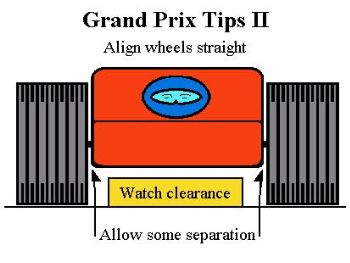| Grand Prix Racing - |
How To Make A Fast Pinewood Car |
Screw the Wheels On
- Hold an axle by the hub with a pair of pliers.
- Place a wheel on the axle.
- Make sure you put the axle in a groove on the side of the car it was
ground and polished for. Holding the axle next to the side of the car,
begin to push it into the axle groove until it stops. When it stops, give
it a twist and push at the same time. It should continue to twist
in.
- Don't twist it in all the way. Leave a little room for the wheel to
move back and forth. If the wheel is plastered against the hub and body,
it will defeat the polished axles and lubrication.
- If a wheel vibrates when you spin it with your fingers, you need to
relubricate that wheel.
- Be sure to check the median clearance. You need at least 3/8ths of an
inch on an AWANA Grand Prix track.
Your wheels are slotted into your car. If you want to cant your wheels
up or down, do so now. Canting may reduce wheel/track friction if you are
not allowed to cut your wheels. Canting is simply angling your axle up or
down so only the outer or inner edge of the wheel touches the track.
Canting wheels up (the axles actually point up a bit)
may help if your wheels have little "beads" on the outer edge (as all three
types of Scout kit wheels do). It is best to remove the beads and smooth
the wheels, but if that's not allowed, canting may help. Some experiments
indicate canting all axles up that way may actually detract from speed.
The wheel bore/body interface should be lubricated, or painted with a
Teflon coating when canting wheels down since body
friction is substantially increased. Bushings between the wheel and body
are usually not allowed.
|
For the serious competitor
| Lifting a front wheel
a fraction of an inch is an advantage if you can make your car roll
straight without bobbing. If it bobs, it will be worse than if it was
not lifted. Bobbing will likely happen if your weight is not back far
enough and there are bumps where your club's track sections join. With
a long wheel base and weight near the rear axle, bobbing is virtually
impossible. |
|---|
|
Before gluing your axles in place, follow this procedure to make sure
your car rolls straight. You will roll your car gently on a glass
or polished surface.
- Draw a straight line on a flat surface or large piece of paper on a
flat surface.
- Roll your car forward, gently along this line and note the amount of
deviation.
- If it wobbles while rolling, either the surface is too rough for this
test or not all the wheels are touching the surface.
- If the car rolls away from you to the left, see if a wheel
on the right is loosing contact with the surface. If so, push its axle
down a bit for better contact. If it rolls to the right, check the left
side wheels for contact.
- If the car is still not rolling straight, either the surface is
unevenly smooth or oily, or an axle groove may not be straight.
- If the car has a lifted wheel and rolls away from that wheel to the
other side, tow the axle of the opposite wheel to the front slightly with
a sliver of wood (or while the hot glue is cooling) in the groove. Tow it
out a bit otherwise.
-
When your axle/wheel configuration is set, burn it in with a glue gun.
Don't over do the glue! If it runs over, it can glue your wheel hub to
the car body. Just a few well-placed drops near the middle and end of
the axle in the groove does fine. Using a glue gun is the best way to
secure your axles because it:
- does not require you to move them while gluing
- holds them tight when cool
- can be melted so you can reposition your axles (heat the glue by
touching the axle over the glue with the tip of the gun; wait a
minute; pull the axle straight out with pliers)
| Grand Prix Racing - |
How To Make A Fast Pinewood Car |
| Copyright © 1997, 2000, 2001, 2002, 2004 by Michael Lastufka, All rights reserved worldwide. |
